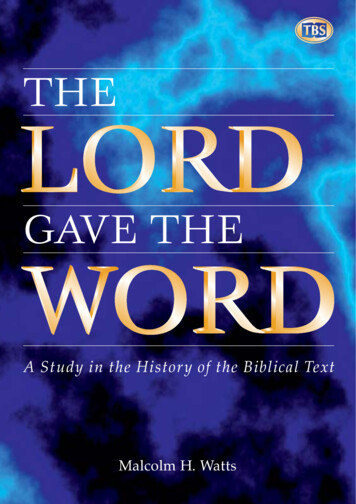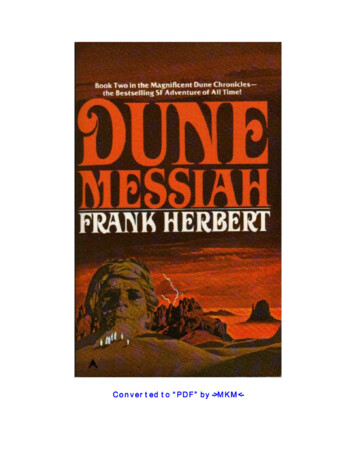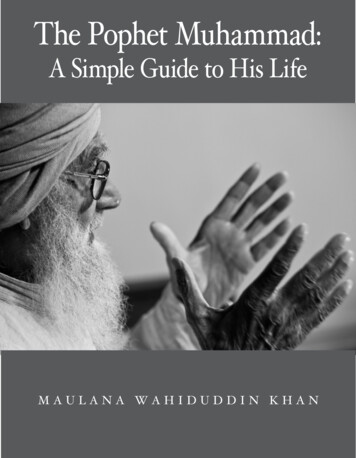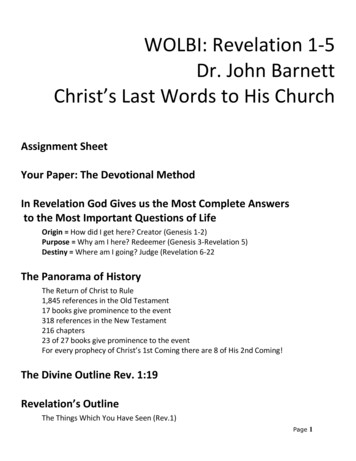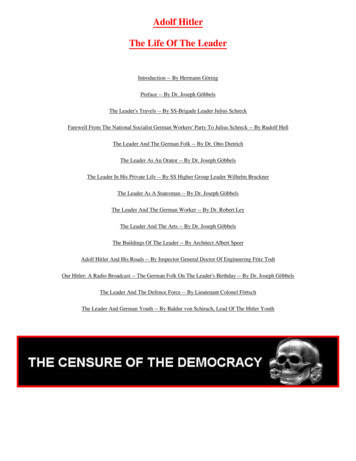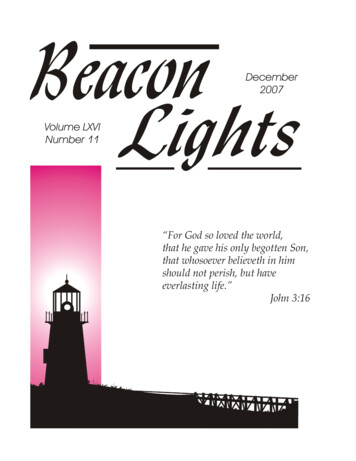
Transcription
December2007Volume LXVINumber 11“For God so loved the world,that he gave his only begotten Son,that whosoever believeth in himshould not perish, but haveeverlasting life.”John 3:16
BEACON LIGHTSTable of Contents3EditorialBlackwater: A Calvinist Crusade?4Fruitful BranchesForgiven Much6Story TimeThe Christmas Story8DevotionalWatching Daily At My Gates —December 9 – January 412Memoir of Rev. C. HankoChapter 29: Trip to Europe—198714Church HistoryThe Upper Room15Gem of the MonthCalled to Minister16Church FamilyUnderstanding What God’s Will Is18Church NewsChurch News19Little LightsA Turn of Events: from Chaos to Comfort (Part 6)EDITORJohn HuizengaSECRETARYKim DoezemaCONTENTS COMMITTEEJohn HuizengaTom CammengaChristiana DeJongTrisha HaakKris MoelkerEXECUTIVE FEDERATION BOARDMatt Overway (President)Daniel Holstege (Vice-President)Sara Huizinga (Secretary)Jeffrey Van Uffelen (Treasurer)Sarah Koole (Librarian)Rachel Nagelkerke (Vice-Secretary)Eric Gritters (Vice-Treasurer)Greg Van Overloop (Youth Coordinator)Rev. Ronald Van Overloop (Spiritual Advisor)Rev. Rodney Kleyn (Spiritual Advisor)PROMOTION COMMITTEEKim DoezemaRachel JoostensPRODUCTION COMMITTEERachel JoostensBUSINESS OFFICEBeacon LightsP.O. Box 144Randolph, WI 53956Phone: (920) 326-6186Email: huizenga@powercom.netBEACON LIGHTS ON TAPEA free service to the legally blind. ContactSam Copple659 Lincoln Avenue, NWGrand Rapids, MI 49504Phone: (616) 774-4132Email: SamCopple@email.msn.comCHURCH NEWS ANNOUNCEMENTSMelinda BleyenbergEmail: darylmel@altelco.net.BOOK SALESBecky KalsbeekTYPESETTERRobert VermeerEDITORIAL POLICYThe articles of Beacon Lights do not necessarily indicate the viewpoint of the Editorial Staff.Every author is solely responsible for the contents of his own article.The Beacon Lights encourages its readers to contact the business office with any questions orcomments. Letters may be edited for printing. We will not publish anonymous letters, but willwithhold names upon request.If any material of Beacon Lights is reprinted by another periodical, we will appreciate your givingthe source and forwarding the printed periodical to the business office. PRINTERJames HuizingaMAILERSBill & Fran LeepBeacon Lights is published monthly by theFederation of Protestant Reformed YoungPeople’s Societies. Subscription price is 10.00. Please send all correspondence,address changes, subscriptions, and articlesubmissions to the business office.Published monthly by the Federation of Protestant Reformed Young Peoples’ SocietiesDecember 2007
EditorialBlackwater:A Calvinist Crusade?by John HuizengaWhat does John Calvin have to do with the fighting in Iraq? More than you’d think, according toJeremy Scahill, the author of Blackwater: the Rise of the World’s Most Powerful MercenaryArmy. Some of the first that you may have heard about Blackwater was back in April, 2004when four Americans were ambushed in Fallujah; their bodies dismembered, burned, and hanged on abridge over the Euphrates amid cheers of “Allah is great.” It turns out that these men were professionalsecurity bodyguards trained by Blackwater and hired by the United States government. In past monthsyou may have noticed Blackwater in the news again; some of their men being charged with obnoxiousbehavior and murder. As I write, Blackwater has become a daily news item. Who are these guys, anyway?Jeremy Scahill alleges that Blackwater’s heart, vision and drive is rooted in the Dutch Calvinism. It’sowner, Erik Prince, is a son of Holland, Michigan where the seed of a Christian community was plantedand flourished for a time.Mr. Scahill explains it likes this: “Dating back to the community’s founding, Holland had long beenrun by Christian patriarchs. In 1846, with a sea-weary clan of fifty-seven fellow Dutch refugees, AlbertusVan Raalte came ashore in western Michigan. Prince’s predecessor had fled his home country because hehad ‘undergone all manner of humiliation and persecution through his defiance of the religious restrictions imposed by the State church.’ After arriving in the United States aboard his vessel, the Southerner,Van Raalte led the clan to the shores of Lake Michigan, where he envisioned a community free to live andworship within the tenets of his brand of Dutch Reform, and without any outside influence. Virtuallythe same description could be applied to Edgar Prince, and eventually to Erik, born nearly a century afterVan Raalte’s death” (2-3). The author continues, “Ed Prince was not an empire builder. He was a Kingdom builder. For him, personal success took a back seat to spreading the Gospel and fighting for themoral restoration of our society” (8).After his death, his son Erik continued to pursue his father’s vision of moral restoration with billionsof dollars in cash at his disposal. His father had established the Prince Corporation of Holland, and thevery successful business was sold to Johnson Controls for 1.35 billion in cash. His sister had also married into the DeVos family, which founded the marketing firm Amway, linking the family with billions ofdollars more. Erik gave generous financial support to right wing politics, religious organizations such asFocus on the Family and the Family Research Council, colleges, mission groups, etc., linking him witha host of powerful men. At some point, he converted to Roman Catholicism and supported conservative Catholic groups as well. His vision and money was a perfect match for men like Chuck Colson andRichard Neuhaus who articulated the vision of Catholics and evangelical Christians working togetherto christianize the world. In a speech at Calvin College in 2002, Chuck Colson praised Erik Prince and“talked extensively about the historical foundation and current necessity of a political and religious alliance of Catholics and evangelicals. Colson talked about his work, beginning in the mid-1980s, withfamed conservative evangelical Protestant minister turned Catholic priest Richard Neuhaus and others tobuild a unified movement. That work ultimately led in 1994 to the controversial document “Evangelicalsand Catholics Together: The Christian Mission in the Third Millennium.” The ECT document articulatedthe vision that would animate Blackwater’s corporate strategy and the politics practiced by Erik Prince—aBEACON LIGHTS
marriage of the historical authority of the Catholic Church with the grassroots appeal of the modern conservative U.S. evangelical movement, bolstered by the cooperation of largely secular and Jewish neoconservatives” (20). Finally, Erik Prince and the vision expressed in the ECT document would be linked tothe United States government. Mr. Scahill continues: “the ECT was not merely a philosophical document.Rather, it envisioned an agenda that would almost identically mirror that of the Bush administration a fewyears later, when Neuhaus would serve as a close adviser to Bush, beginning with the 2000 campaign. The manifesto was years in the making and would greatly assist the unifying of the conservative movement that made George W. Bush’s rise to power possible” (20-22).With a vision in place to Christianize the world, connections with men in high places, plenty ofmoney, experience as a Navy SEAL, and business savvy, Erik Prince began to develop “Blackwater,”a world class military training camp in a swamp in North Carolina. The U.S. military had been steadilydownsizing, and plans to use private military personnel were in the works. When terrorists attacked theTwin Towers, Blackwater was ready to help with the response. As the war developed, Blackwater grewexponentially as it received millions of dollars in contracts from the U.S. government. Now Blackwaterhas become one of the world’s most powerful mercenary armies, with enough power to overthrow thegovernments of the smallest countries in the world. It has plans to build two more training camps, one inIllinois, and one in California.Jeremy Scahill is very alarmed that such power is in the hands of conservative Christians. He writes,“What is particularly disturbing about the “expanding role” of Blackwater specifically is the issue of thecompany’s right-wing leadership, its proximity to a whole slew of conservative causes and politicians, itsChristian fundamentalist agenda and secretive nature, and its deep and longstanding ties to the RepublicanParty, U.S. military, and intelligence agencies. Blackwater is quickly becoming one of the most powerfulprivate armies in the world, and several of its top officials are extreme religious zealots, some of whomappear to believe they are engaged in an epic battle for the defense of Christendom. The deployment offorces under this kind of leadership in Arab or Muslim countries reinforces the worst fears of many in theIslamic world about a neo-Crusader agenda masquerading as a U.S. mission to “liberate” them from theiroppressors” (374-375).Scahill puts together a vast amount of research and provides a compelling story. When this information is viewed in light of the theological movement of the Federal Vision and the goal of a kingdom ofGod on this earth, I am inclined to agree that once again a distorted view of the kingdom of God could beproducing a 21st century crusade. We watch the developments with godly discernment, and busy ourselveswith the preaching of the gospel, raising our children in the fear of the Lord, and the gathering of God’speople into the kingdom of heaven. John Calvin would have nothing to do with the compromise and unityof evangelicals with the Roman church to christianize the world. Neither do we. “For here have we nocontinuing city, but we seek one to come” (Hebrews 13:14). vFruitful BranchesForgiven Muchby Andy Tanis“Wherefore I say unto thee, Her sins, which are many,are forgiven; for she loved much: but to whom little isforgiven, the same loveth little” (Luke 7:47). Beloved, in order to properly understand what this text is saying, wemust consider what had just takenplace prior to the time that Jesus made thisDecember 2007
statement. Most of us can probably recall the circumstances that led to this truth proclaimed by our Lord. Wewill take a brief moment to recall why this statement isrecorded in God’s Word, and how it is applied to everybeliever today. In order to do this, we must first take alook at the setting.First of all, the story begins with an invitation extended to Jesus by a Pharisee named Simon who desiredto have Jesus come and eat at his house. Jesus willinglywent to Simon’s house, and ate at his table. While theywere eating, a woman in the city came into the housewith an alabaster box of very costly ointment. One thingmentioned about this woman is that she was a sinner.She approaches the place at the table where Jesus was,trembling in the deep awareness of her sin and misery.Weeping all the while, she washes Jesus’ feet with hertears and dries his feet with her hair. Worshipping Him,she continues by kissing His feet. In spite of the staresfrom those gathered in the room, she continues to honorJesus by anointing His feet with this costly ointment.This she did in the presence of all who were there.Her love for the Lord was so great that none of this attention that she received by the others mattered. The Pharisee himself looks at the sight with disgust. In unbelief,he questions the knowledge and righteousness of Christ.“This man, if He were a prophet, would have knownwho and what manner of woman this is that touchethHim: for she is a sinner,” he thought to himself. Surelya righteous man would want nothing to do with such awretch, and would certainly be quick to rebuke her andsend her away!Jesus knew Simon’s thoughts and proceeds in telling the parable of a creditor which had two debtors; onedebtor owing 500 pence, and the other 50 pence. Whenthey had nothing to pay, the creditor cancels their debt,and forgives them both. Jesus then asked Simon whichdebtor will love the creditor the most. We can rightfullysay that Simon was using common sense when he toldJesus that the debtor who would love his creditor mostwould be the one who had the greatest debt cancelled.Jesus then explained that the situation with this womanwas no different. Since her sins were many and her debtto the Lord was great; He gave her the assurance that shehad been forgiven for all her sins. Hence, her love forher Lord could no longer be contained.It would be wise to consider this event figuratively,and focus on the contrast between the characteristicsdisplayed by those who are forgiven much and the characteristics displayed by those who are forgiven little.BEACON LIGHTSSimon’s attitude is clearly portrayed as an attitudeof pride and self-righteousness. He displays himself tobe one who is “forgiven little” by his lack of love andconcern for this godly woman, and ultimately for ChristHimself. He represents those who look at the law merelyfrom an external aspect, and will hold to their own “goodworks” to give them a free ticket to heaven. These peopleestablish their own righteousness as if they are the standard for all to imitate. Matthew 23 goes into great detailexplaining the kind of attitude that was characteristic ofthe Pharisees. In Matthew 23, Jesus confirms that, insteadof receiving God’s favor, these people receive God’sjudgment. Because Simon held this woman in contempt,refusing to acknowledge her to be forgiven, he testifiedby his lack of love that his sins were not forgiven.The woman here represents the people of God in thedeep consciousness of their unworthiness. Imagine withme, if you will, a child who has just been chastised byhis father for doing something wrong. This child can’tbear the thought of being under his father’s wrath andanger. So with fear and trembling, he timidly approacheshis father. With true sorrow in his heart, he pleads withhis father to forgive him, and not to be angry. He says,“I’m sorry, Dad. I have sinned against you and I’m sorry.Please forgive me!” The woman, by her actions, displaysa genuine sorrow for her sins, and in godly faith seeksJesus, believing Him to be the source of her salvation,and there finding hope for deliverance.One who is truly righteous must look away fromhimself to Jesus, the “author and finisher of our faith”(Hebrews 12:2). The people of God will only be drawn toChrist and look to Him for forgiveness if the Holy Spiritfirst convicts them of their sin. They may not look at thelaw externally, but must go deeper to consider the impossibility of keeping the least of God’s commandments. TheHoly Spirit does this by giving them a deep awarenessthat they have provoked the Holy God, and stand exposedto His wrath. The believer must be humbled to truly sayfrom the heart, “Surely, I am the chief of sinners! Thereis no one on earth that could possibly be less worthy ofGod’s favor than me.”This broken, humbled sinner will see himself as naked in God’s sight, and in his shame will approach God’sthrone of grace seeking to be the recipient of aboundingmercy and love. He comes to Christ in holy fear, byfaith believing that he will “in no wise be cast out” fromcommunion with his Savior and Redeemer. He comes toChrist, believing not only that those sins are forgiven,but that he is still loved by God. He finds all of his own
righteousness to be filthy rags, and seeks salvation outside of himself. By faith, He looks to the cross of Christand the work accomplished on that cross.The church, the true Israel of God, consists of thesepeople who have tasted and seen that the Lord is good.These are they which have heard the voice of their Redeemer saying, “Neither do I condemn thee; go, and sinno more.” The one who has been forgiven much willabound in the work of the Lord, seeking to bring hopeto the believer who is under a heavy burden of sin. Paulexhorts the church at Ephesus to be “kind one to another,tenderhearted, forgiving one another, even as God forChrist’s sake hath forgiven you.” (Ephesians 4:32).The most striking feature to notice here is that thosewho are the recipients of an overwhelming amount offorgiveness will seek to show love throughout theirlives. This love is shown in obedience to the commandof Christ. Jesus says, “This is my commandment that yelove one another; that your joy may be full.” Those wholove will live thankful lives, and be full of happiness andjoy. They will seek not their own welfare, but will seekto be used by God to bring hope in the life of another.After Jesus teaches His disciples and us the Lord’sPrayer in Matthew 6, he says, “For if ye forgive men theirtrespasses, your heavenly Father will also forgive you:But if ye forgive not men their trespasses, neither willyour Father forgive your trespasses.” (verses 14, 15). Thispassage brings out the necessity for us to truly forgivefrom the heart. Others will see our joy and respond bysaying, “Truly, this love and joy is a clear testimony thatthis person has been with Jesus, and he has experiencedthe forgiveness of sins.” vAndy is a member of Hope Protestant Reformed Churchin Walker, Michigan.Story TimeThe Christmas StoryBy Sarah Mowery“Don’t you love Christmas?”I glance up from my grocery list to look at the womannext to me. She smiles a wide smile. A jaunty Santa capperches on her curly hair, and two little elves danglefrom her ears.“Don’t you love Christmas?” she asks again, andthen continues, “I just love Christmas—the carols, thecards, the decorations, the gifts, the food, the story.Ijust can’t wait!” She pauses long enough to grab a boxof Stove Top stuffing from the shelf and to wink at mychildren before sauntering down the aisle, humming“Jingle Bells” as she goes.I push my shopping cart past the meat department,where turkeys and hams are on sale this week, and a rowof tiny, blinking Christmas trees line the counter. Evenhere in the grocery store, carols ring out, and boxedChristmas cards and trinkets flank the ends of the aisles.I duck my head as under an arch of gaudy tinsel bells,and the words of the woman pass through my mind, “Thecarols, the cards, the decorations, the gifts, the food, thestory ” The story. What story does she have in mind? I wonder to myself as I hand my daughter a package ofbutter to place in our cart. My one-year-old son points at aparade of Santas, Rudolphs, and Frostys that bob from theceiling as we make our way past the frozen goods. Oneof those Christmas stories? Or the Christmas story?A big “Countdown to Christmas” calendar greets usas we approach the cash register. One by one, I lift thegroceries from my cart as a lady over the loud speakersings about children waiting impatiently for Santa. Theteller grins at my two little ones as she hands them each acandy cane. “So are you guys getting anxious for Christmas?” she asks them, and then she shakes her head at me.“The season starts so early nowadays; kids have to waittwice as long for the day to finally arrive!”The courtesy worker loads the groceries into mytrunk and I strap Leah and Will into their car seats. Thesparkling lights of a Christmas tree in the window of anearby store catch my eye. Not so long ago, when I wasin college, I worked part-time at that small store, ringingup customers who came in to buy fresh flowers, homedécor, or specialty coffees. Our store would start receivDecember 2007
ing ceramic snowmen and snowflake ornaments alreadyin June, and the season’s new Christmas trees made theirdebut in early October. Among all of those shimmeringlights and glittery ribbons, the smell of peppermint-flavored lattes wafting through the air, I remember feelingas if I “just couldn’t wait for Christmas.”I drive home, carry my two sleeping toddlers intothe house, and tuck them into their beds for a nap. As Ihaul my groceries into the house and begin putting themaway, my mind wanders again to the woman who saidthat she “just can’t wait” for Christmas, and “the story”that she added onto the list of things that she loves aboutthe season almost as an afterthought.Are you waiting anxiously for Christmas? What does“Christmas” mean to you?Long before Clement Clark Moore’s eager childrennestled all snug in their beds, or Dickens’ EbenezerScrooge, or Dr. Seuss’ Grinch, holy men of old pennedthe Christmas story. It’s a story that begins before thebeginning, in the eternal counsel of God. It’s a story thatwas first spoken on earth to Adam and Eve, as they stoodsoon to be banished from the Garden of Eden. There Godpromised them the seed that would crush the head of theserpent. Throughout the rest of their earthly pilgrimage ina world now cursed because of their sin, Adam and Evelonged for the coming of that Savior, and they diligentlytaught their children the blessed “Mother Promise.” Andso, Abel looked for the fulfillment of the sacrifice thathe made to God. Likewise Enoch and Noah, Abrahamand Sarah, received God’s promise of redemption andsaw the realization of that promise afar off. They werepersuaded of the certainty of the coming of the promisedseed, and they lived embracing that hope. Isaac, too,dwelled in the land to which his father had been sent,that physical land that pictured the spiritual reality, forhe also sought a heavenly country. The patriarch Jacobspoke to his children of the coming of Shiloh even onhis deathbed. Moses by faith instructed God’s people tokeep the Passover and led them through the Red Sea andthe wilderness back to the Promised Land, which theypossessed under the leadership of Joshua, “Jehovah Salvation.” Throughout the years of the judges, the kings, theprophets, and the captivity, true children of God longedfor the fulfillment of that promise for the birth of theMessiah, the Christ. They looked for the day when theirKing, the Son of David, would come to make them rightwith God. They were waiting waiting for the day thatwe remember as “Christmas.”And that day came. You know the story, don’t you?The Christmas story? Come to Bethlehem. See the youngBEACON LIGHTSvirgin who labors and brings forth Jesus, “Jehovah Salvation,” her firstborn child, wraps him in rags, and layshim in a feed trough. This scene is not the one I sawdisplayed as I entered the grocery store earlier today,the one with the smiling, golden-haired woman, andthe serene, chubby baby laying on shimmering yellowhay. Nor is it the one of which the lady crooned over theloudspeaker, the one in which the cattle are lowing, butthe baby utters not a sound.There was no room for this child. No room in the inn,no room in Bethlehem, no room in Israel, no room in yourheart, no room in mine. As Isaiah foretold, if we wereto have seen this humble baby lying there, he would nothave looked beautiful to us. This child is humbly clothed,he lies in rough manger, and he cries like no other childhas or will ever cry. Why? Look a little closer.Neither you nor I would want to bring forth ourchild in a barn. We who are used to clean, comfortablehospital rooms would refuse to give birth lying in thefilth and the stench of farm animals. And yet, who isthis child born tonight? Who put this child there? You.And me. This Jesus is the Child that the Church bringsforth. We put that tiny baby in that dirty manger, and hecried out on that night as he bore already then the uglyweight of our sin. Look one more time, and see, evenmore startlingly, that confined in the helpless body ofthis tiny infant is God.Christmas comes and goes every year, and yet, tothe believer, the story never grows old. It’s not a tale ofSanta, Rudolph, or even a cozy nativity scene. It’s thestory of the dirty, rotten, shamefulness of our sin, andthe Savior God who stooped down to earth and came asa baby to bear our curse for us.But that’s not the end of the Christmas story—there’smore. We read in the gospels that the child Jesus grewand found favor with God and man. As a boy he had tolearn the Old Testament Scriptures just like you and Idid, only as he read the Old Testament prophecies, heread about himself, the longed-for fulfillment of thosepromises. As he entered adulthood, Jesus lost the favorof many men, for few were they who sought that heavenly country. And so, the man Jesus lived the life of asuffering stranger, until his persecution culminated inhis being mocked, beaten, and crucified as all aroundridiculed him. Who would do that to a man? Who coulddo that to God? You. And me.As I put the last of the groceries on the table andbegin setting the table for supper, I glance out the window. The wind has picked up, and tiny, white flakes areswirling to the ground. There’s still more to the story:
the angels sang, remember? And the shepherds, whenthey saw that crying babe in the crude trough, praisedGod! For that same longed-for Messiah who was killedas a fulfillment of all those lambs slaughtered in the OldTestament is the Star out of Jacob and the Scepter thatrises out of Israel. He lives! And He is coming again,the One whose life and death have opened our way intothe heavenly kingdom for which the Old Testamentsaints, too, so desperately longed. The hopes and fearsof all the years were fulfilled in Bethlehem that night.For the little babe born and the man crucified is Christby highest heaven adored, Christ our Everlasting Lord.Rejoice! Immanuel has come to thee, O Israel. And Hecomes again!Are we waiting anxiously for Christmas? What does“Christmas” mean to us?Is Christmas all about trimming our tree or agonizing over what gifts to buy for those on our lists? Likethe lady in the grocery store, do we celebrate the carols,the cards, the decorations, the gifts, the food or is aChristmas a season in which our love for our Lord isrenewed? We have a different reason to celebrate, don’twe? To the point that we spend more time with the merrydistractions of the season than we spend in adoration ofand fellowship with our Savior, they become tools thatthe Tempter successfully uses to draw us farther fromhim. A different reason to celebrate calls for a differenttype of celebration.Supper is just on the table as my husband’s car pullsinto the driveway. My children, up from their naps, standby the window, and they erupt with squeals of delightas Daddy makes his way inside. I stoop by them, notingthe drifts that are sweeping ‘round the house. I smile tomyself as the inspired words of the prophet Isaiah cometo my mind, “Though your sins be as scarlet, they shallbe as white as snow.”That is the story of Christmas. What a beautiful story!What a glorious gospel!Don’t you love Christmas? vSarah is a member of Doon Protestant Reformed Churchin Doon, Iowa.DevotionalWatching DailyAt My Gatesby Skip HunterDecember 9 Read I Peter 3:19-22In an earlier passage we looked at being ready togive an answer. Here we have an example of Noah whopreached for 120 years to people who did not want tohear. We must never give up in our witnessing. God willuse our faithful witness for his glory and the benefit ofthe elect. This will be for our benefit as well as those towhom we witness. We also have the comfort of the factof Christ’s resurrection, ascension, and sitting at the righthand of God. With Jesus our advocate we have no reasonto fear those who may try to harm us. Sing Psalter 273.December 10 Read Psalm 8Young people you spend many hours at school andhome studying science. All of science is God’s creation.As we study various parts of God’s creation, we need toremember who we are and who God is. Because we are created beings ourselves, we must never pretend to bewiser than our creator. We have many responsibilities ashead of creation; we must never misuse them. Finallyverse 9 must be foremost in our minds. In all of creationwe must seek to see the excellent name of God. SingPsalter 15.December 11 Read Psalm 16:1-11This Psalm has been one of great comfort to God’speople in every age. There are many verses from whichwe can gain comfort and instruction. In verse one thePsalmist prays that God will preserve him. He says thathe trusts in the Lord and in that trust he can pray. Preservation of God means much. It means that he preservesus in all the trials in this life, and it means that he willpreserve us until he brings us to heaven. Because of thiswe can trust him to do everything for us in a way that isDecember 2007
good for us. Now you pick a verse and think about it fora short time. Then don’t forget to pray. Sing Psalter 29.December 12 Read Psalm 19:1-6Students and teachers alike profit from studying Psalm19. First of all, we have guidance in what we study increation. It does not have to be astronomy. God’s handiwork is visible in chemistry, human anatomy, and othersciences as well. Because God is a God of order, we canfind orderliness in all of creation. We also can see Christin all of creation as well. As we learned yesterday, Godpreserves his people. In creation we have a picture ofthat preservation. Sing Psalter 37.December 13 Read Colossians 1:1-10Let’s look at a New Testament passage today. Paul inhis epistles was writing to real people. He was also byinspiration writing to the church of all ages. We can takepersonal instruction in each of his epistles. Verses 9-10are what I wish to point out today. First of all youngpeople, your parents and grandparents spend many hoursin prayer for you. They especially try to pray for yourspiritual life. They want you to do well and succeed inyour lives, but they are more desirous that you “walkworthy of the Lord” in all that you do. This is akin toJohn rejoicing to hear that his children are “walking inthe truth”. Continue to learn about our God and Savior,and he will grant the desires of your heart.December 14 Read Colossians 1:11-20Two ideas come to mind in reading through this passage. First of all, we see who Christ is and for whatpurpose he was created. As I said a few days ago we cannot help but in creation see who our creator is. Verse 16tells us that by Christ, remember John 1, all things werecreated by him but also they were created for him. Secondly, verse twenty brings to us great comfort. Becauseof the cross we are reconciled to him. God’s people areblessed because they can
Twin Towers, Blackwater was ready to help with the response. As the war developed, Blackwater grew exponentially as it received millions of dollars in contracts from the U.S. government. Now Blackwater has become one of the world's most powerful mercenary armies, with enough power to overthrow the governments of the smallest countries in the .
